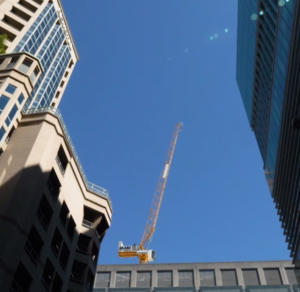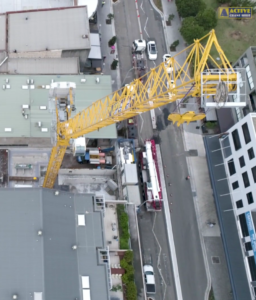LATEST NEWS
Project Problems a Permanent Onsite Crane Can Help Address
Cranes are essential to the success of all major construction projects, and to many small to medium projects as well. They are an onsite workhorse, absolutely vital for moving and transporting heavy loads around the site.
Thus, choosing the right crane for your project is a vital decision. You will need to take into account many factors, most especially the terrain of your site (and access to it), the required reach and load capacity of any crane, and both your timescale and budget.
Different cranes offer different advantages and you will need to choose between mobile and vehicle mounted cranes, or permanent onsite crane options: tower cranes and self-erecting cranes.
Choosing the Right Crane for the Job
Vehicle-mounted cranes are the right option for some projects — for example, those requiring the crane to be used flexibly and in multiple locations, such as in highway and pipeline construction. However, a permanent onsite crane usually offers the most time- and cost-efficient option for most longer term and larger size construction sites.
A tower crane is a feature of most large construction sites and is used to lift heavy construction equipment and materials. It is anchored to a concrete base.
A self-erecting crane is a more flexible option. They are designed to be simple to install, with the installation taking a day or less. They are also simple to use and are remote-controlled. Self-erecting cranes are ideal for projects six or fewer storeys high.
How Can a Permanent Onsite Crane Help?
Permanent onsite cranes offer solutions to many issues that frequently arise during construction projects. Here are four common construction site problems they can help you address:
1. Overcoming Material Handling Inefficiency
Are you concerned that materials are not being handled quickly or efficiently enough? Is this slowing the project down?
Efficiency is key in any construction project. Everything and everyone must be highly organised in order to hit deadlines and milestones, and for the project to be completed on time. Time must be well-utilised to optimise productivity and minimise costs. Therefore, delays in materials handling can be costly.
Material handling inefficiency can slow the project’s momentum and therefore cause higher workforce and other costs if the project exceeds time estimates. Having a permanent onsite crane can overcome this issue, reducing construction time by ensuring that materials are always in the right place at the right time.
With the onsite team freed from the duties of moving materials, they are able to focus solely on construction work which, in turn, propels project momentum and reduces the risk of employee burnout.
By organising materials well, having a proper lifting sequence in place, and keeping a permanent onsite crane in operation, you can have your material handling completely streamlined, saving you both time and costs.
2. Working Around Space Limitations
Is your site too small for a tower crane or mobile crane? Is it hard to keep materials organised on site because of its small dimensions?
On sites with limited space, a self-erecting crane is ideal for the job. These cranes can slot into almost any site. They are quick to erect, with minimal ground preparation required.
Despite the more compact size of a self-erecting crane, it still has excellent range and lift capacity. Your material handling needs will be completely covered. A self-erecting crane can lift and move a range of items with great precision, including rafters, pallets of bricks, steel beams and skips.
A small site can also be difficult to organise so that the safety of personnel is looked after. A permanent onsite crane can help keep the site orderly and tidy so that these risks are minimised.
Space limitations can also be Air Space Limitations. On high rise sites where a self-erecting crane is not tall enough, you may also have air space issues.
For example, neighbouring buildings may not be agreeable to any part of the Tower Crane’s jib extending over their building during manoeuvres. Likewise… if the construction site is next to a railway corridor or a busy highway, then there could be extensive delays in getting permission for the Tower Crane’s jib to overhang these areas even temporarily.
The perfect solution to air space limitations is the new Potain MCH 125 Electro Hydraulic Luffing Crane. The hydraulic luffing design means the crane has a shorter counter-jib and therefore overhang. It’s out-of-service radius is significantly smaller when compared with rope-luffing alternatives.
The MCH 125 is able to raise its jib from a horizontal level to 87˚ in less than 2 minutes so combined with the shorter counter-jib, it is able to operate within tight air space limits.
3. Minimising Neighborhood and Environmental Disruption
Are you concerned about the impact of construction on local residents, wildlife and the surrounding environment?
The neighborhood also benefits when you use a permanent onsite crane. Firstly, it reduces construction time, therefore minimising local residents’ exposure to construction noise and disruption.
By avoiding the use of a mobile crane, however infrequently, you also help to ease traffic congestion and disruption as it comes and goes from the site.
There are also options for electric and emission-free permanent onsite cranes. These are ideal for keeping pollution and noise levels as low as possible.
4. Staying Within Budget Limitations
Are you worried that budgets are being stretched too far?
Reducing construction time is the principal way to keep costs in check. A permanent onsite crane is certainly one way of preventing delays to the project and keeping costs down.
Hiring a self-erecting crane on a short-term basis makes a very cost effective option. Consider that self-erecting crane hire costs are significantly less than the manpower costs to perform the tasks handled by the crane. More often than not, no amount of manpower could in fact perform the tasks. So, even with the additional cost of a crane operator, you are still likely to reduce outgoings on materials handling.
Hiring, or even purchasing, a permanent onsite crane should definitely be considered to maximise productivity, safety and profitability. Have you hired a permanent onsite crane for a project before? How did it impact the project? Let us know in the comments below.


CONTACT US
Get in touch and let us know how we can help.
Address: 8 Ainslie Cl, Somersby NSW 2250